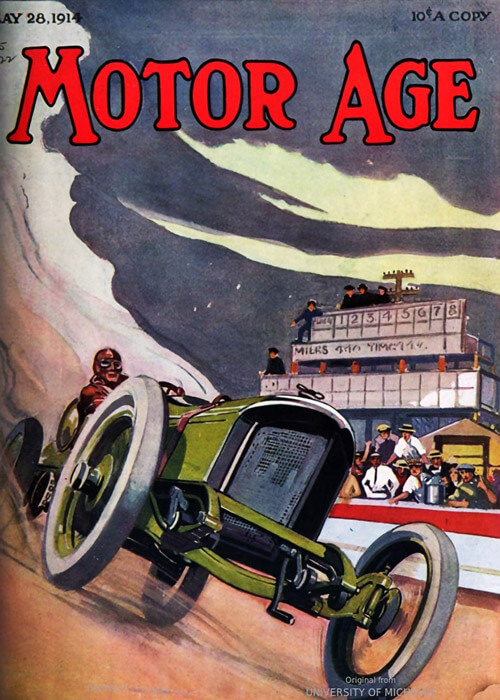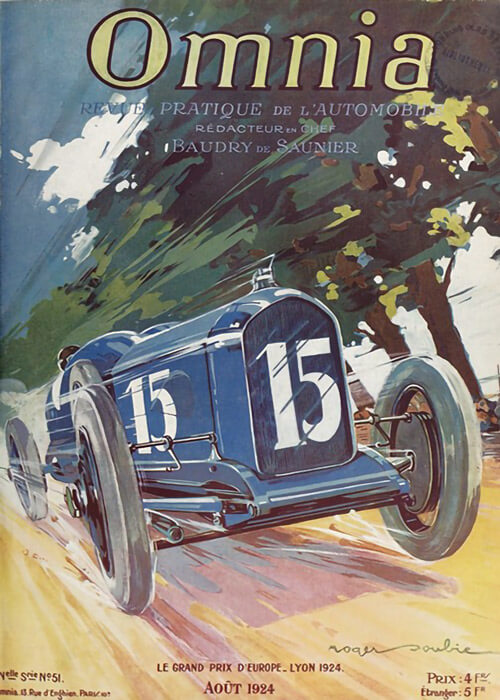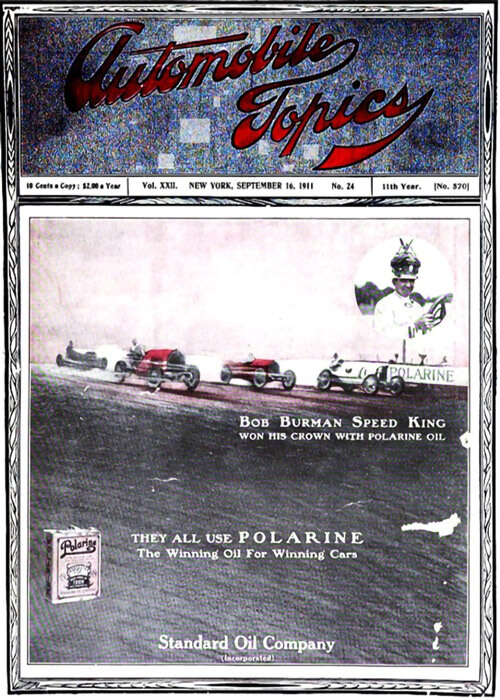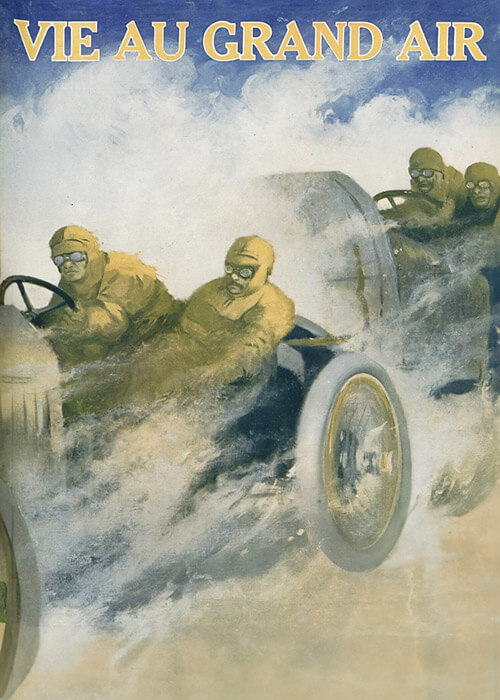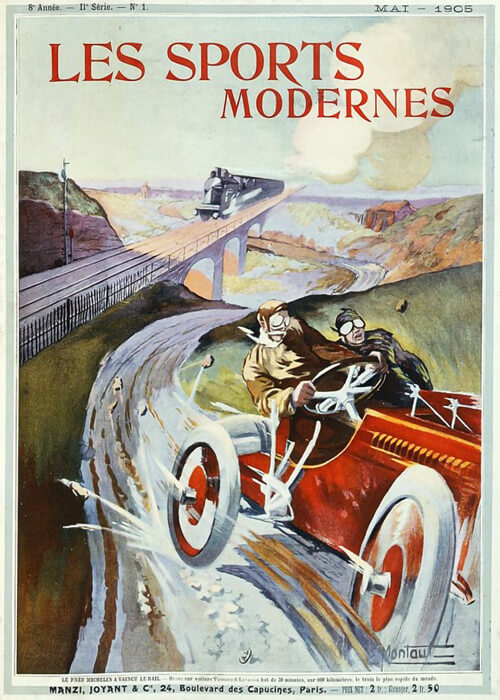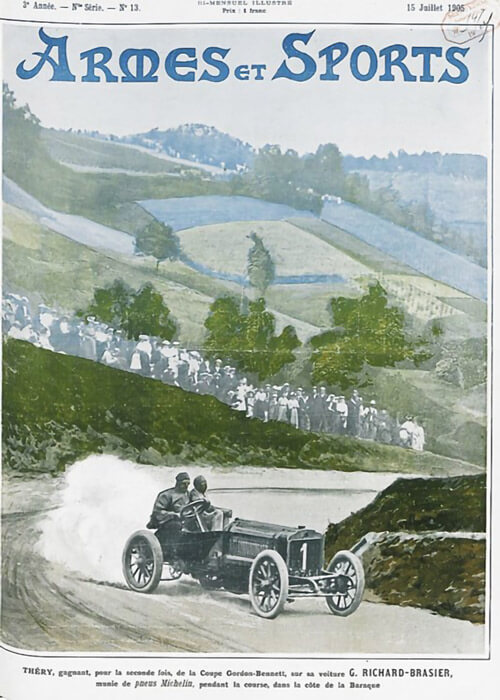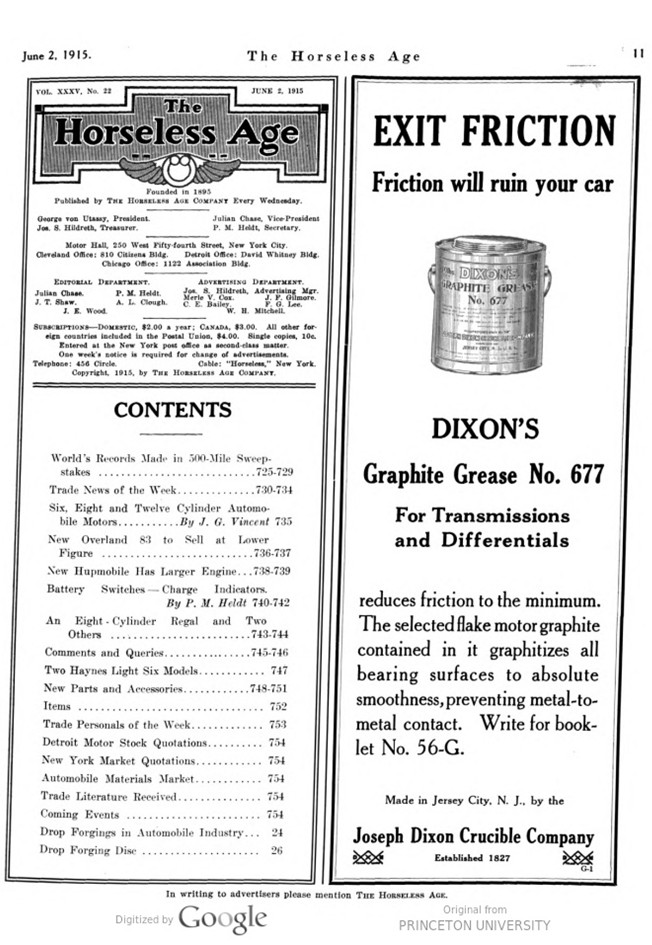
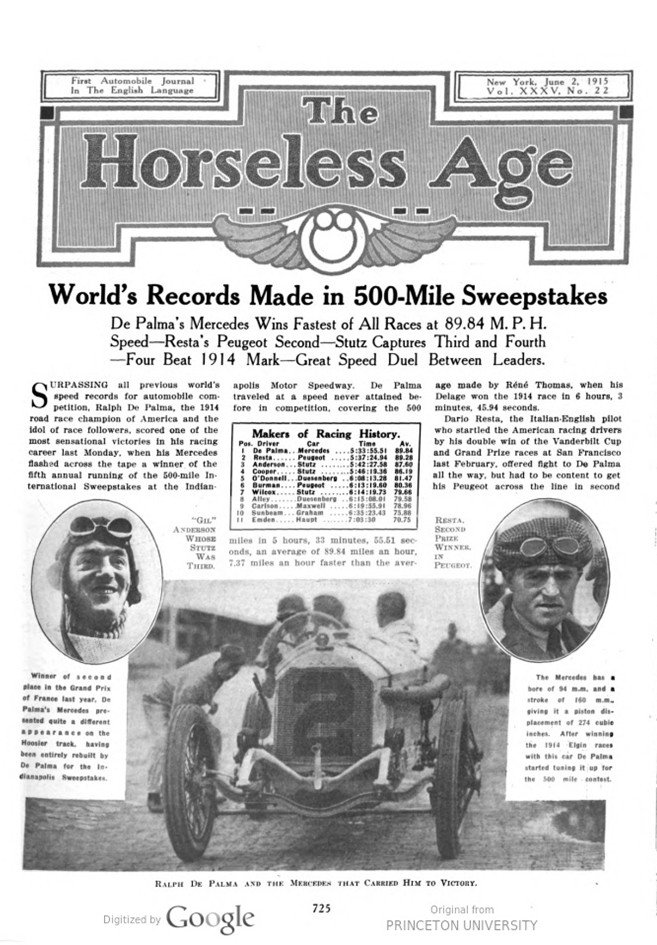
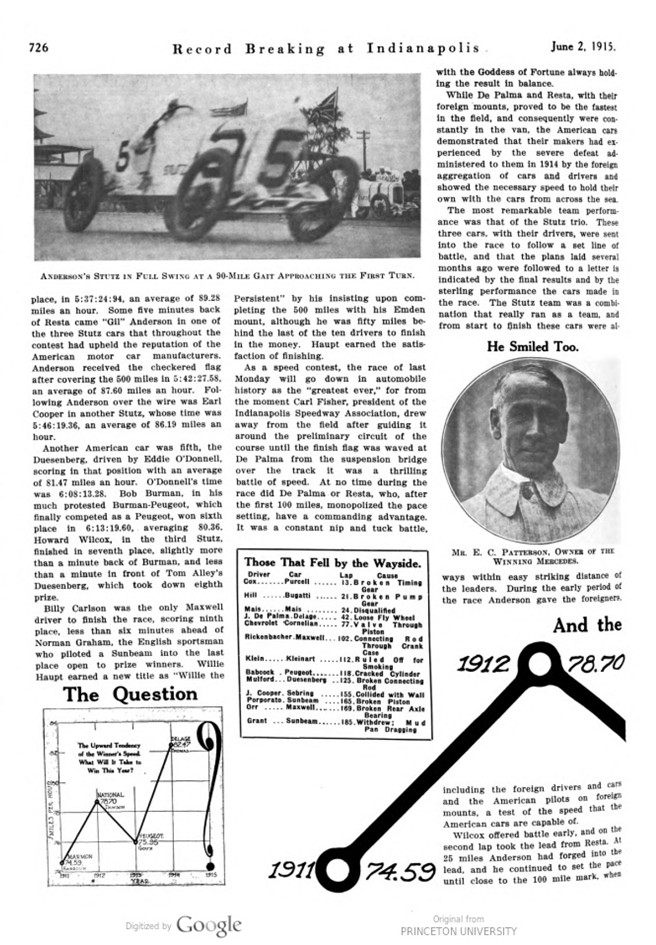
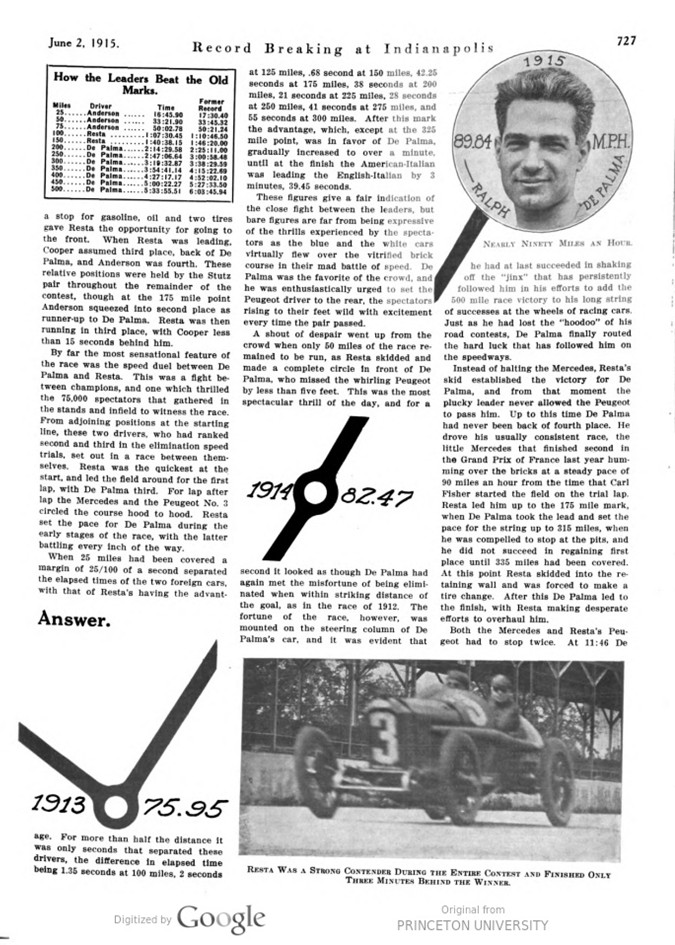
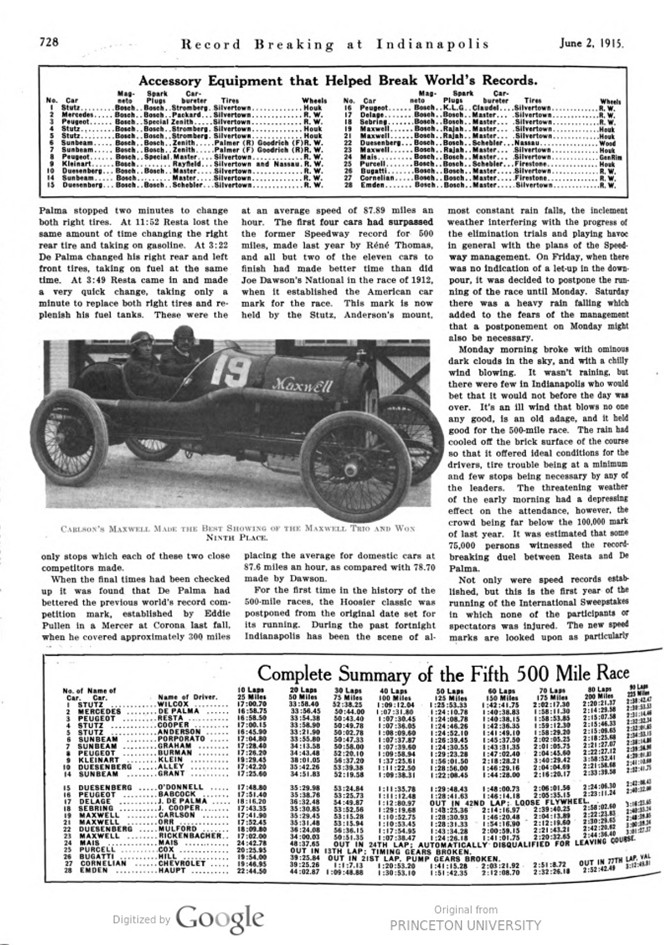
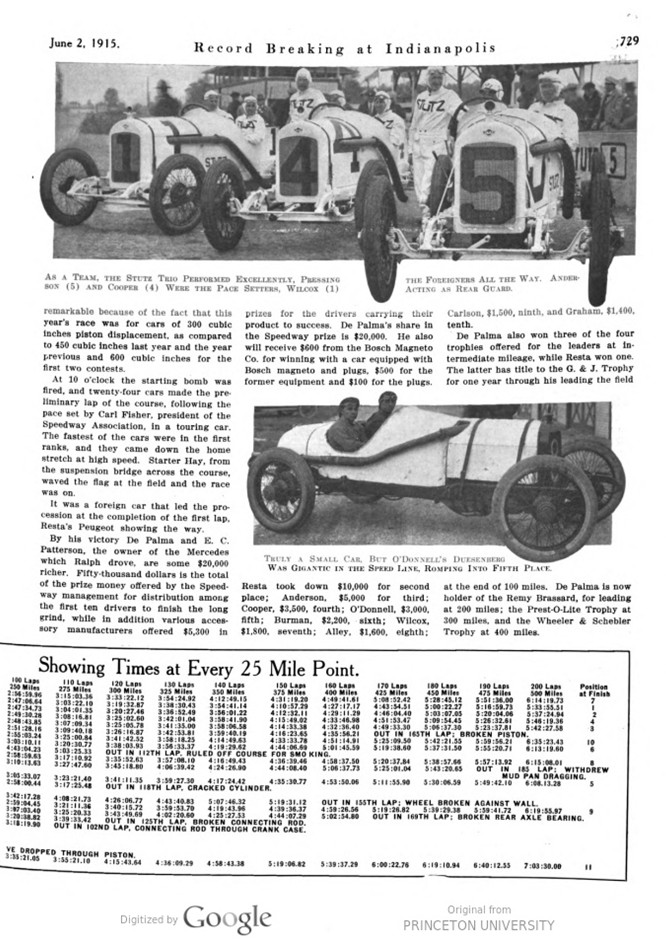
Text and jpegs by courtesy of hathitrust.org www.hathitrust.org, compiled by motorracinghistory.com
Horseless Age, Vol. 35, No. 22, June 2, 1915
World’s Records Made in 500-Mile Sweepstakes
De Palma’s Mercedes Wins Fastest of All Races at 89.84 M. P. H. Speed
Resta’s Peugeot Second – Stutz Captures Third and Fourth
Four Beat 1914 Mark – Great Speed Duel Between Leaders.
SURPASSING all previous world’s speed records for automobile competition, Ralph De Palma, the 1914 road race champion of America and the idol of race followers, scored one of the most sensational victories in his racing career last Monday, when his Mercedes flashed across the tape a winner of the fifth annual running of the 500-mile International Sweepstakes at the Indianapolis Motor Speedway. De Palma traveled at a speed never attained before in competition, covering the 500 miles in 5 hours, 33 minutes, 55.51 seconds, an average of 89.84 miles an hour, 7.37 miles an hour faster than the average made by Réné Thomas, when his Delage won the 1914 race in 6 hours, 3 minutes, 45.94 seconds.
Makers of Racing History.
Pos. Driver Car Time Av.
1 De Palma Mercedes 5:33:55.51 89.84
2 Resta Peugeot 5:37:24.94 89.28
3 Anderson Stutz 5:42:27.58 87.60
4 Cooper Stutz 5:46:19.36 86.19
5 O’Donnell Duesenberg 6:08:13.28 81.47
6 Burman Peugeot 6:13:19.60 80.36
7 Wilcox Stutz 6:14:19.73 79.66
8 Alley Duesenberg 6:15:08.01 79.58
9 Carlson Maxwell 6:19:55.91 78.96
10 Sunbeam Graham 6:35:23.43 75.88
11 Emden Haupt 7:03:30 70.75
Dario Resta, the Italian English pilot who startled the American racing drivers by his double win of the Vanderbilt Cup and Grand Prize races at San Francisco last February, offered fight to De Palma all the way, but had to be content to get his Peugeot across the line in second place, in 5:37:24:94, an average of 89.28 miles an hour. Some five minutes back of Resta came „Gil“ Anderson in one of the three Stutz cars that throughout the contest had upheld the reputation of the American motor car manufacturers. Anderson received the checkered flag after covering the 500 miles in 5:42:27.58, an average of 87.60 miles an hour. Following Anderson over the wire was Earl Cooper in another Stutz, whose time was 5:46:19.36, an average of 86.19 miles an hour.
Another American car was fifth, the Duesenberg, driven by Eddie O’Donnell, scoring in that position with an average of 81.47 miles an hour. O’Donnell’s time was 6:08:13.28. Bob Burman, in his much protested Burman-Peugeot, which finally competed as a Peugeot, won sixth place in 6:13:19.60, averaging 80.36. Howard Wilcox, in the third Stutz, finished in seventh place, slightly more than a minute back of Burman, and less than a minute in front of Tom Alley’s Duesenberg, which took down eighth prize.
Billy Carlson was the only Maxwell driver to finish the race, scoring ninth place, less than six minutes ahead of Norman Graham, the English sportsman who piloted a Sunbeam into the last place open to prize winners. Willie Haupt earned a new title as „Willie the Persistent“ by his insisting upon completing the 500 miles with his Emden mount, although he was fifty miles behind the last of the ten drivers to finish in the money. Haupt earned the satisfaction of finishing.
As a speed contest, the race of last Monday will go down in automobile history as the „greatest ever,“ for from the moment Carl Fisher, president of the Indianapolis Speedway Association, drew away from the field after guiding it around the preliminary circuit of the course until the finish flag was waved at De Palma from the suspension bridge over the track it was a thrilling battle of speed. At no time during the race did De Palma or Resta, who, after the first 100 miles, monopolized the pace setting, have a commanding advantage. It was a constant nip and tuck battle, with the Goddess of Fortune always holding the result in balance.
Those That Fell by the Wayside.
Driver Car Lap Cause
Cox Purcell 13. Broken Timing Gear
Hill Bugatti 21. Broken Pump Gear
Mais Mais 24. Disqualified
J. De Palma Delage. 42. Loose Fly Wheel
Chevrolet Cornelian 77. Valve Through Piston
Rickenbacher Maxwell 102. Connecting Rod Through Crank Case
Klein Kleinart 112. Ruled Off for Smoking
Babcock Peugeot 118. Cracked Cylinder
Mulford Duesenberg 125. Broken Connecting Rod
J. Cooper Sebring 155. Collided with Wall
Porporato Sunbeam 165. Broken Piston
Orr Maxwell 169. Broken Rear Axle Bearing
Grant Sunbeam 185. Withdrew; Mud Pan Dragging
While De Palma and Resta, with their foreign mounts, proved to be the fastest in the field, and consequently were constantly in the van, the American cars demonstrated that their makers had experienced by the severe defeat administered to them in 1914 by the foreign aggregation of cars and drivers and showed the necessary speed to hold their own with the cars from across the sea.
The most remarkable team performance was that of the Stutz trio. These three cars, with their drivers, were sent into the race to follow a set line of battle, and that the plans laid several months ago were followed to a letter is indicated by the final results and by the sterling performance the cars made in the race. The Stutz team was a combination that really ran as a team, and from start to finish these cars were always within easy striking distance of the leaders. During the early period of the race Anderson gave the foreigners, including the foreign drivers and cars and the American pilots on foreign mounts, a test of the speed that the American cars are capable of.
Wilcox offered battle early, and on the second lap took the lead from Resta. At 25 miles Anderson had forged into the lead, and he continued to set the pace until close to the 100-mile mark, when a stop for gasoline, oil and two tires gave Resta the opportunity for going to the front. When Resta was leading, Cooper assumed third place, back of De Palma, and Anderson was fourth. These relative positions were held by the Stutz pair throughout the remainder of the contest, though at the 175-mile point Anderson squeezed into second place as runner-up to De Palma. Resta was then running in third place, with Cooper less than 15 seconds behind him.
How the Leaders Beat the Old Marks.
Miles Driver Time Former Record
25 Anderson 16:45.90 17:30.40
50 Anderson 33:21.90 33:45.32
75 Anderson 50:02.78 50:21.24
100 Resta 1:07:30.45 1:10:46.50
150 Resta 1:40:38.15 1:46:20.00
200 De Palma 2:14:29.58 2:25:11.00
250 De Palma 2:47:06.64 3:00:58.48
250 De Palma 3:19:32.87 3:38:29.59
250 De Palma 3:54:41.14 4:15:22.69
400 De Palma 4:27:17.17 4:52:02.10
450 De Palma 5:00:22.27 5:27:33.50
500 De Palma 5:33:55.51 6:03:45.94
By far the most sensational feature of the race was the speed duel between De Palma and Resta. This was a fight between champions, and one which thrilled the 75,000 spectators that gathered in the stands and infield to witness the race. From adjoining positions at the starting line, these two drivers, who had ranked second and third in the elimination speed trials, set out in a race between themselves. Resta was the quickest at the start, and led the field around for the first lap, with De Palma third. For lap after lap the Mercedes and the Peugeot No. 3 circled the course hood to hood. Resta set the pace for De Palma during the early stages of the race, with the latter battling every inch of the way.
When 25 miles had been covered, a margin of 25/100 of a second separated the elapsed times of the two foreign cars, with that of Resta’s having the advantage. For more than half the distance it was only seconds that separated these drivers, the difference in elapsed time being 1.35 seconds at 100 miles, 2 seconds at 125 miles, .68 second at 150 miles, 42.25 seconds at 175 miles, 38 seconds at 200 miles, 21 seconds at 225 miles, 28 seconds at 250 miles, 41 seconds at 275 miles, and 55 seconds at 300 miles. After this mark the advantage, which, except at the 325-mile point, was in favor of De Palma, gradually increased to over a minute, until at the finish the American Italian was leading the English Italian by 3 minutes, 39.45 seconds.
These figures give a fair indication of the close fight between the leaders, but bare figures are far from being expressive of the thrills experienced by the spectators as the blue and the white cars virtually flew over the vitrified brick course in their mad battle of speed. De Palma was the favorite of the crowd, and he was enthusiastically urged to set the Peugeot driver to the rear, the spectators rising to their feet wild with excitement every time the pair passed.
A shout of despair went up from the crowd when only 50 miles of the race remained to be run, as Resta skidded and made a complete circle in front of De Palma, who missed the whirling Peugeot by less than five feet. This was the most spectacular thrill of the day, and for a second it looked as though De Palma had again met the misfortune of being eliminated when within striking distance of the goal, as in the race of 1912. The fortune of the race, however, was mounted on the steering column of De Palma’s car, and it was evident that he had at last succeeded in shaking off the „jinx“ that has persistently followed him in his efforts to add the 500-mile race victory to his long string of successes at the wheels of racing cars. Just as he had lost the „hoodoo“ of his road contests, De Palma finally routed the hard luck that has followed him on the speedways.
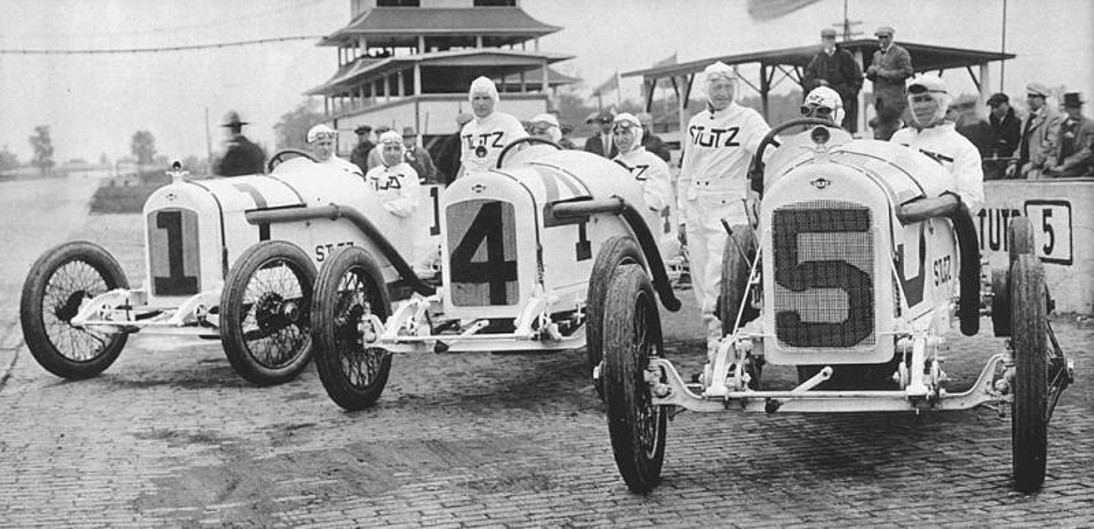
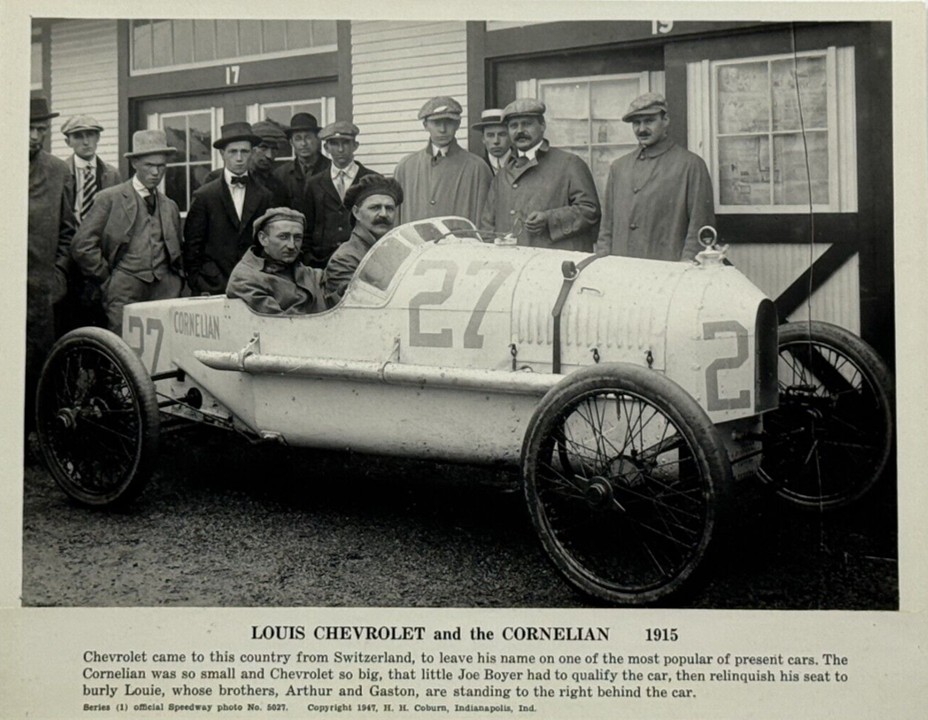
Instead of halting the Mercedes, Resta’s skid established the victory for De Palma, and from that moment the plucky leader never allowed the Peugeot to pass him. Up to this time De Palma had never been back of fourth place. He drove his usually consistent race, the little Mercedes that finished second in the Grand Prix of France last year humming over the bricks at a steady pace of 90 miles an hour from the time that Carl Fisher started the field on the trial lap. Resta led him up to the 175-mile mark, when De Palma took the lead and set the pace for the string up to 315 miles, when he was compelled to stop at the pits, and he did not succeed in regaining first place until 335 miles had been covered. At this point Resta skidded into the retaining wall and was forced to make a tire change. After this De Palma led to the finish, with Resta making desperate efforts to overhaul him.
Both the Mercedes and Resta’s Peugeot had to stop twice. At 11:46 De Palma stopped two minutes to change both right tires. At 11:52 Resta lost the same amount of time changing the right rear tire and taking on gasoline. At 3:22 De Palma changed his right rear and left front tires, taking on fuel at the same time. At 3:49 Resta came in and made a very quick change, taking only a minute to replace both right tires and replenish his fuel tanks. These were the only stops which each of these two close competitors made.
When the final times had been checked up it was found that De Palma had bettered the previous world’s record competition mark, established by Eddie Pullen in a Mercer at Corona last fall, when he covered approximately 300 miles at an average speed of 87.89 miles an hour. The first four cars had surpassed the former Speedway record for 500 miles, made last year by Réné Thomas, and all but two of the eleven cars to finish had made better time than did Joe Dawson’s National in the race of 1912, when it established the American car mark for the race. This mark is now held by the Stutz, Anderson’s mount, placing the average for domestic cars at 87.6 miles an hour, as compared with 78.70 made by Dawson.
For the first time in the history of the 500-mile races, the Hoosier classic was postponed from the original date set for its running. During the past fortnight Indianapolis has been the scene of almost constant rain falls, the inclement weather interfering with the progress of the elimination trials and playing havoc in general with the plans of the Speedway management. On Friday, when there was no indication of a let-up in the downpour, it was decided to postpone the running of the race until Monday. Saturday there was a heavy rain falling which added to the fears of the management that a postponement on Monday might also be necessary.
Monday morning broke with ominous dark clouds in the sky, and with a chilly wind blowing. It wasn’t raining, but there were few in Indianapolis who would bet that it would not before the day was over. It’s an ill wind that blows no one any good, is an old adage, and it held good for the 500-mile race. The rain had cooled off the brick surface of the course so that it offered ideal conditions for the drivers, tire trouble being at a minimum and few stops being necessary by any of the leaders. The threatening weather of the early morning had a depressing effect on the attendance, however, the crowd being far below the 100,000 mark of last year. It was estimated that some 75,000 persons witnessed the record-breaking duel between Resta and De Palma.
Not only were speed records established, but this is the first year of the running of the International Sweepstakes in which none of the participants or spectators was injured. The new speed marks are looked upon as particularly remarkable because of the fact that this year’s race was for cars of 300 cubic inches piston displacement, as compared to 450 cubic inches last year and the year previous and 600 cubic inches for the first two contests.
At 10 o’clock the starting bomb was fired, and twenty-four cars made the pre- liminary lap of the course, following the pace set by Carl Fisher, president of the Speedway Association, in a touring car. The fastest of the cars were in the first ranks, and they came down the home stretch at high speed. Starter Hay, from the suspension bridge across the course, waved the flag at the field and the race was on.
It was a foreign car that led the procession at the completion of the first lap, Resta’s Peugeot showing the way.
By his victory De Palma and E. C. Patterson, the owner of the Mercedes which Ralph drove, are some $20,000 richer. Fifty thousand dollars is the total of the prize money offered by the Speedway management for distribution among the first ten drivers to finish the long grind, while in addition various accessory manufacturers offered $5,300 in prizes for the drivers carrying their product to success. De Palma’s share in the Speedway prize is $20,000. He also will receive $600 from the Bosch Magneto Co. for winning with a car equipped with Bosch magneto and plugs, $500 for the former equipment and $100 for the plugs. Resta took down $10,000 for second place; Anderson, $5,000 for third; Cooper, $3,500, fourth; O’Donnell, $3,000, fifth; Burman, $2,200, sixth; Wilcox, $1,800, seventh; Alley, $1,600, eighth; Carlson, $1,500, ninth, and Graham, $1,400, tenth.
De Palma also won three of the four trophies offered for the leaders at intermediate mileage, while Resta won one. The latter has title to the G. & J. Trophy for one year through his leading the field at the end of 100 miles. De Palma is now holder of the Remy Brassard, for leading at 200 miles; the Prest-O-Lite Trophy at 300 miles, and the Wheeler & Schebler Trophy at 400 miles.


Photo captions.
Page 725
„GIL“ ANDERSON WHOSE STUTZ WAS THIRD. – RESTA, SECOND PRIZE WINNER, IN PEUGEOT.
Winner of second place in the Grand Prix of France last year, De Palma’s Mercedes presented quite a different appearance on the Hoosier track, having been entirely rebuilt by De Palma for the Indianapolis Sweepstakes.
The Mercedes has a bore of 94 m.m. and a stroke of 160 m.m., giving it a piston dis- placement of 274 cubic inches. After winning the 1914 Elgin races with this car De Palma started tuning it up for the 500-mile contest.
RALPH DE PALMA AND THE MERCEDES THAT CARRIED HIM TO VICTORY.
Page 726
ANDERSON’S STUTZ IN FULL SWING AT A 90-MILE GAIT APPROACHING THE FIRST TURN.
He Smiled Too. MR. E. C. PATTERSON, OWNER OF THE WINNING MERCEDES.
Page 727
1915 – 89.84 M.P.H – RALPH PALMA – NEARLY NINETY MILES AN HOUR.
RESTA WAS A STRONG CONTENDER DURING THE ENTIRE CONTEST AND FINISHED ONLY THREE MINUTES BEHIND THE WINNER
page 728
CARLSON’S MAXWELL MADE THE BEST SHOWING OF THE MAXWELL TRIO AND WON NINTH PLACE.
Page 729
AS A TEAM, THE STUTZ TRIO PERFORMED EXCELLENTLY, PRESSING THE FOREIGNERS ALL THE WAY. ANDERSON (5) AND COOPER (4) WERE THE PACE SETTERS, WILCOX (1) ACTING AS REAR GUARD. TRULY A SMALL CAR, BUT O’DONNELL’S DUESENBERG WAS GIGANTIC IN THE SPEED LINE, ROMPING INTO FIFTH PLACE.
